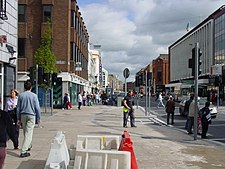Newtown Pery, Limerick
This article needs additional citations for verification. (December 2013) |

Newtown Pery (
History

Prior to the development of Newtown Pery, the historical City of Limerick was situated just north of the present day city centre, stretching from
Following the turbulent years of the 17th century, Limerick began to prosper in the 18th century and was completely transformed into the city it is today.
The boundaries of the city of Limerick, where the
By the turn of the 19th century, Newtown Pery was rapidly growing as most fashionable area of the city. In 1807 its leading residents secured a
Details

From its development Newtown Pery has served as Limerick's
Limerick continued to expand following the
Decline

Although housing an important collection of Georgian architecture and acting as Limerick's city centre, unfortunately Newtown Pery's position as the one time fashionable area of the city is long over. In addition to this, its Georgian heritage has been severely compromised, in particular around the retail core of
Economic stagnation in Limerick was only broken by the Celtic Tiger in the late 20th century. But Newtown Pery still lagged behind with regards to investment and planning, with exception to the riverfront of the Shannon. Suburban areas of Limerick have seen massive investments, particularly in retail, which has seen the onetime retail core of O' Connell Street and William street been eclipsed by massive retail developments in the suburbs such as the Crescent Shopping Centre in Dooradoyle. Poor planning and lack of investment has resulted in high vacancy rates and further dereliction, which plagues some parts. Amongst the casualties of this poor planning has been the Patrick Street, Rutland Street and Ellen Street areas.[citation needed] These streets are now almost completely derelict and vacant. Urban depression in Limerick is not confined to these areas, and much of central Limerick is now exhibiting the effects, mainly of heavy suburbanisation but also the effects of economic recession.[original research?]
Future
In order to arrest the decline of Limerick's CBD and Newtown Pery in general, both
Landmarks

The following are a list of notable buildings and landmarks in the area:
- Customs House, (Hunt Museum) Rutland Street
- Old City Hall, Rutland Street
- Augustinian Church, O'Connell Street
- Franciscan Church, Henry Street (closed)
- The Crescent, Double Crescent shaped Georgian Development
- Sacred Heart Church, The Crescent
- O'Connell Monument, The Crescent
- Dominican Church, Glentworth Street
- Tait Monument, Baker Place
- Spring Rice Memorial, People's Park
- Pery Square tontine development, Pery Square
- The People's Museum of Limerick, Pery Square
- Limerick City Gallery of Art, Pery Square
- Limerick Athenaeum (Theatre Royal), Cecil Street (closed)
- Belltable Arts Centre, O'Connell Street (Currently closed)
- Limerick War Memorial (Cenotaph), Pery Square
- Colbert Station, Parnell Street
- Frank McCourt Museum & Leamy Art Gallery, Hartstonge Street
- Georgian House & Garden, Pery Square
- St. Michael's Church of Ireland, Pery Square
- St. Joseph's Church, Quinlan Street
- Sarsfield Bridge
- Shannon Rowing Club, Clubhouse, Sarsfield Bridge
- Riverpoint, Bishop's Quay
- Clarion Hotel, Steamboat Quay
See also
Further reading
- Willie Cumming, Mildred Dunne and Barry O'Reilly (Editors), An Introduction to the Architectural Heritage of Limerick City. National Inventory of Architectural Heritage (N.I.A.H.), ISBN 9780-7557-74418.
References
- ^ a b "Limerick City Topography - Topographical Dictionary of Ireland (1837)". www.libraryireland.com.
- ^ a b c d e O'Flaherty, Eamon. "Three towns: Limerick since 1691" (PDF) – via Limerick City Council.
- ^ https://www.nli.ie/sites/default/files/2022-12/121_limerick.pdf
- ^ "Pery". 21 June 2013.
- ^ a b "Limerick Georgian Quarter History ' GeorgianQuarter ' Guide". Archived from the original on 16 December 2013.
- ^ a b "Planning Dispatch by Garry Miley - Irish Planning Analysed, Planning Ireland - The Conservation of Georgian Limerick 1". www.garrymiley.com.
- ^ a b "Commissioners for the Improvement of St. Michael's Parish, 1810-1851". Archives. Limerick City and County Council. Retrieved 26 February 2015.
- ^ a b c Lovett, Phil. "The Wellesley Bridge" (PDF). The Old Limerick Journal (9): 28–31.
- ^ Ó Maidín, Pádraig. "The Building of the Sarsfield Bridge" (PDF). Old Limerick Journal (6): 5–6.
- ^ https://www.buildingsofireland.ie/buildings-search/building/21512010/sarsfield-bridge-sarsfield-street-ennis-road-limerick-municipal-borough-limerick-limerick
- ^ a b "Limerick City Council".
- ^ "What's New - Limerick.ie, The official guide to Limerick, Ireland". Archived from the original on 17 March 2013.
